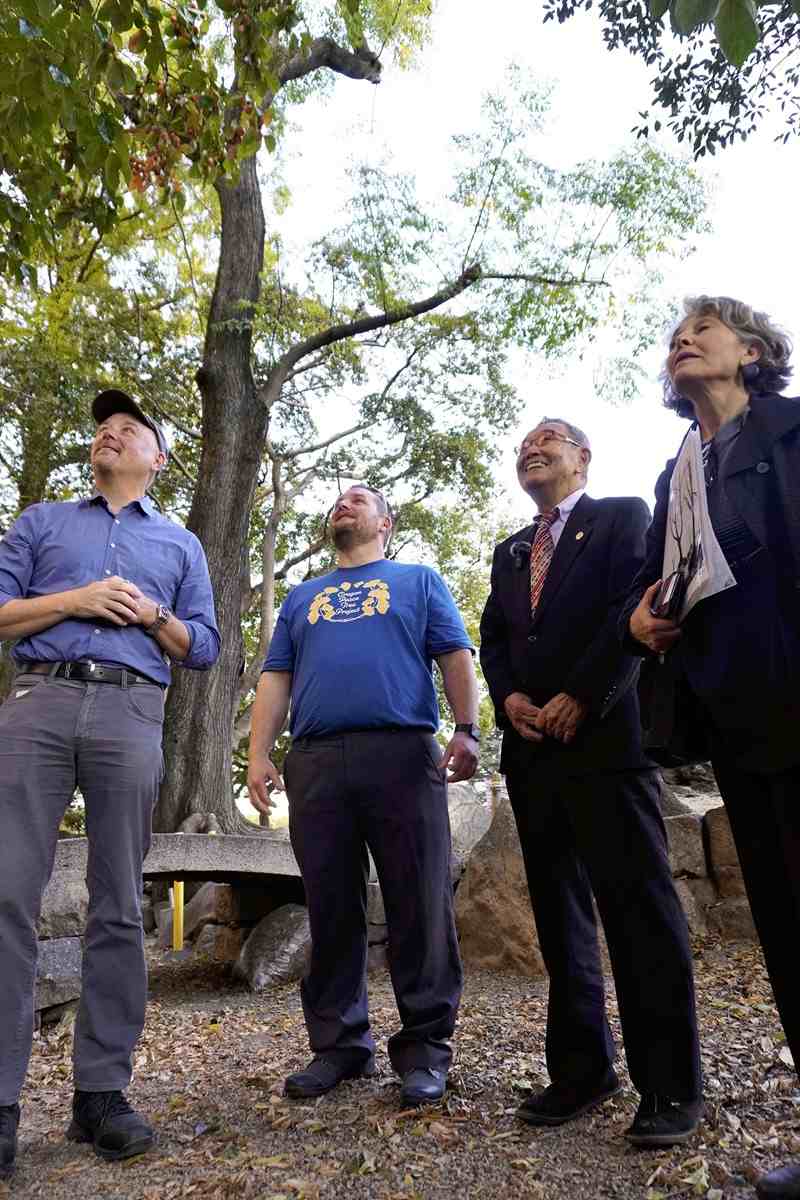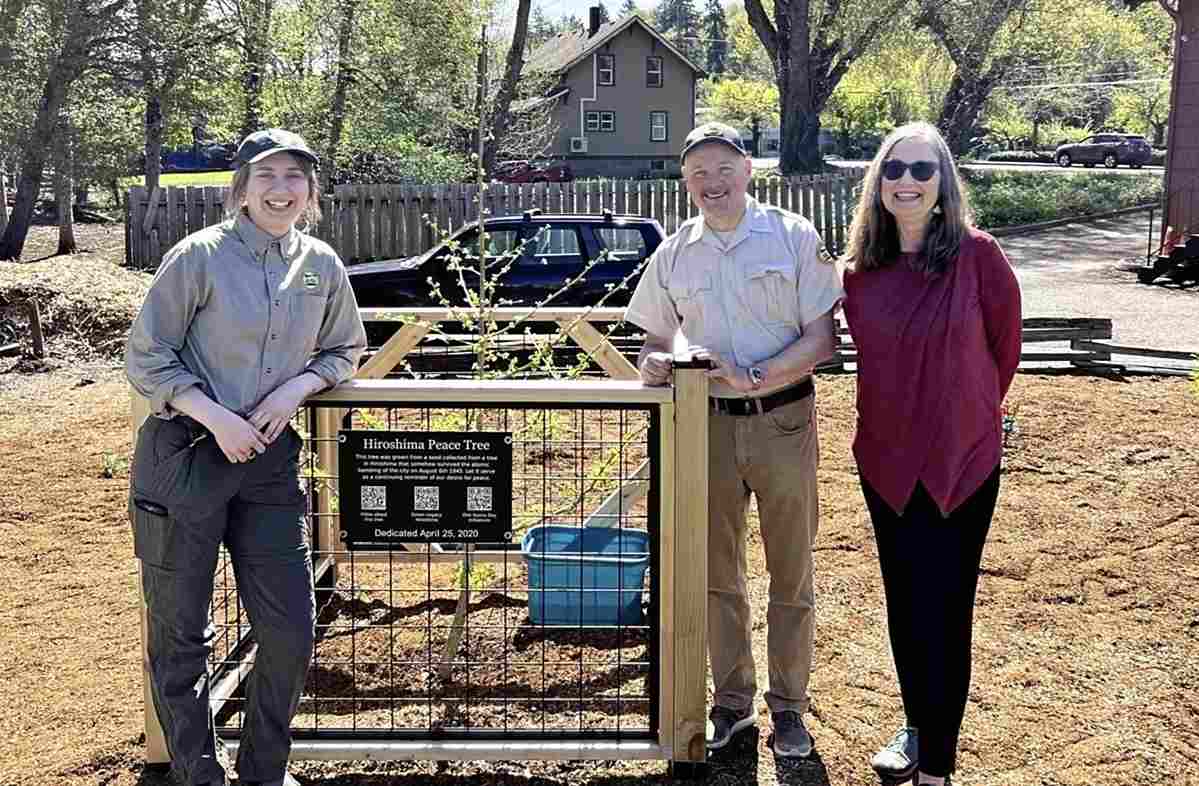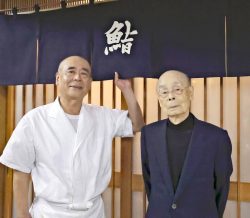
A group of visitors from the U.S. state of Oregon look up at an atomic bombed tree while listening to Chikara Horiguchi, an arborist, second from right, in Naka Ward, Hiroshima, on Nov. 7.
11:10 JST, December 9, 2023
HIROSHIMA — “Hibakujumoku” or atomic-bombed trees, which survived the atomic bomb strike in Hiroshima, are spreading to various parts of the world as “silent witnesses of the tragedy.”
Members of the Green Legacy Hiroshima (GLH), a citizens group based in Hiroshima, have collected seeds from such trees and shipped them to nearly 130 locations in about 40 countries and regions around the world. Many of these seeds have taken root in those places and have grown into saplings.
During the atomic blast in August 1945, the surface temperature at the hypocenter is said to have reached 3,000 to 4,000 C. Wooden buildings within two kilometers were all crushed by blast and trees were burnt. It was said that no grass or trees would grow for the next 75 years in Hiroshima. However, several months after the bombing, some trees in the city sprouted buds, giving hope to the citizens who had survived the atomic bombing.
In 1996, the Hiroshima municipal government began registering surviving trees that had existed within two kilometers of the hypocenter at the time of the bombing, based on the testimonies of residents and on-site investigations, in an aim to protect them.
In 2011, an activity to send seeds and seedlings from those trees to other countries started based on the idea of Iran native Nassrine Azimi, the first director of the Hiroshima office of the U.N. Institute for Training and Research. After she retired as the director, she established the GLH in cooperation with a nonprofit organization in the city and took over the activity.
Second generation
A group of six people from the U.S. state of Oregon, one of the recipients of the seeds, visited Hiroshima in early November and touched some of the atomic-bombed trees.
The six people included Mike Oxendine, a horticultural engineer, and Jim Gersbach, an official from the Oregon Department of Forestry. Seeds and seedlings from ginkgo, persimmon, camphor and other species of trees had been sent to Oregon via the GLH. Now, about 160 “second-generation” trees are growing at parks and other places in the state.
On Nov. 7, the visitors offered a prayer before the Cenotaph for the Victims of the Atomic Bomb and — guided by Azimi and others — took a tour to visit bombed trees in the city. They listened to an explanation from Chikara Horiguchi, a 78-year-old arborist who helps preserve bombed trees, in front of persimmon and muku trees that survived the blast near Shirakami-sha shrine in Naka Ward, Hiroshima.
According to Oxendine, a persimmon tree that was planted about three years ago in Oregon has grown to about four meters tall and its growth is much faster than expected. Gersbach asked if the exposure to the atomic bomb could affect the growth of second-generation trees.

A second-generation bombed tree planted in Oregon in 2020 is seen in this photo taken in April.
Horiguchi said that the cold climate in the state would help the tree’s growth, but he added, “I don’t know whether or not there is any effect from exposure to the atomic bomb, but I think since their mother trees survived the harsh environment, the second-generation trees are trying to grow strong and fast.”
While Azimi, 64, is concerned about the current international situation, including ongoing conflicts, she has hope in the fact that the “seeds of peace” are being planted and are taking root around the world.
“The seeds from A-bombed trees are a crystal-clear message from Hiroshima. I hope as many people as possible are involved in the activity and learn to value both people and nature,” she said.
Documentary
A documentary is being produced featuring Hideko Tamura, who survived the atomic bombing in Hiroshima when she was 11 years old and currently lives in Oregon, where she is working hard to plant seeds and saplings from bombed trees.
David-Paul B. Hedberg, the director of a documentary titled “The Seeds of Peace,” recently visited Japan for the first time to shoot in Hiroshima. He said that he wanted to carefully film bombed trees and the people trying to pass them on to future generations.

A preview of what has already been filmed in the United States was held in Hiroshima.
Tomoko Watanabe, 69, co-founder of the GLH, said after watching it, “I hope the director will actually touch A-bombed trees to feel the reality of Hiroshima where the atomic bomb destroyed not only people but also all living things and reflect that feeling in the documentary. ”
The GLH has been sending seeds and seedlings from hibaku trees to both domestic and overseas recipients since July 2011. Recipients plant them at parks, schools and gardens of public facilities.
For example, a ginkgo tree was planted in front of the U.N. Office at Geneva. In Norway, many saplings are grown at the botanical garden of the University of Oslo and distributed to recipients in the country. The initiative by the GLH was chosen as the “Heritage for the Future Project 2014” by the National Federation of UNESCO Associations in Japan, which is sponsored by The Yomiuri Shimbun.

A 10-meter-tall eucalyptus tree at the Hiroshima Castle site.
A-bombed trees
Currently, there are about 160 such trees in nearly 50 locations, including those that have been transplanted. They include various species such as eucalyptus trees and weeping willows. Some of the trees have lost their vitality during the 78 years since the bombing. The need to pass these trees on to future generations is growing.
Related Tags
"Features" POPULAR ARTICLE
-

Sanrio to Open Museum in Yamanashi Pref. Dedicated to Founder, Exhibits Include Hello Kitty, Other Characters
-

Legendary Sushi Chef Jiro Ono Turns 100: ‘I Have No Regrets’
-

Autumn Foliage Surrounds Visitors to Tokyo’s Showa Kinen Park
-

My Daughter No Longer Speaks to Me, But I Want to See Her and My Grandchild
-

Kumamoto: Public Bath Refurbished as Library Where You Can Chat, Take Photos
JN ACCESS RANKING
-

Keidanren Chairman Yoshinobu Tsutsui Visits Kashiwazaki-Kariwa Nuclear Power Plant; Inspects New Emergency Safety System
-

Imports of Rare Earths from China Facing Delays, May Be Caused by Deterioration of Japan-China Relations
-

University of Tokyo Professor Discusses Japanese Economic Security in Interview Ahead of Forum
-

Japan Pulls out of Vietnam Nuclear Project, Complicating Hanoi’s Power Plans
-

Govt Aims to Expand NISA Program Lineup, Abolish Age Restriction
























